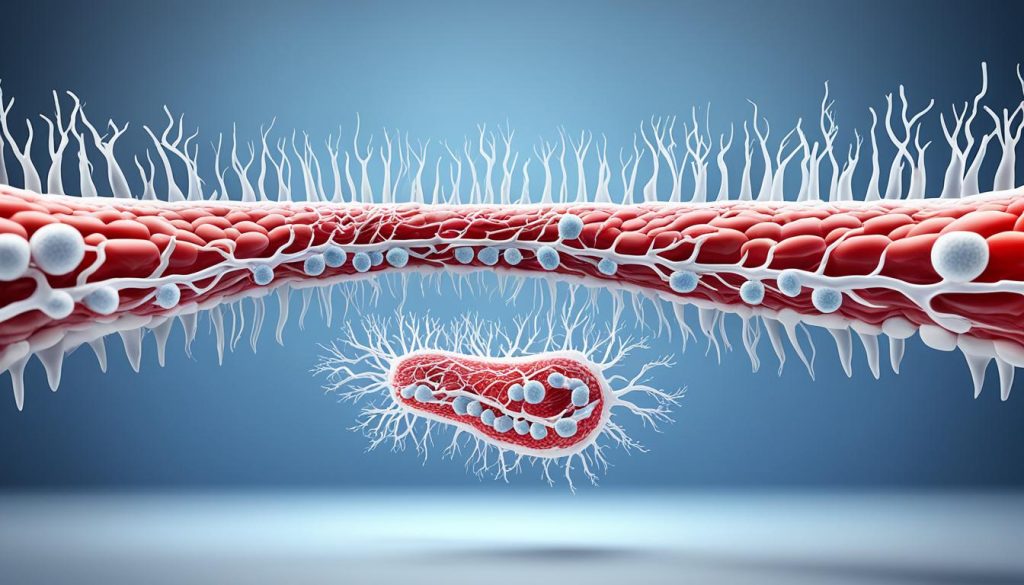High levels of triglycerides in the blood can increase the risk of heart disease. Fortunately, there are several effective strategies and dietary tips to help lower triglyceride levels quickly. By making simple lifestyle changes and adopting a healthy diet, you can improve your heart health and maintain optimal triglyceride levels.
If you’re wondering how to lower triglycerides, reduce triglycerides, or decrease triglyceride levels, you’ve come to the right place. In this article, we will explore ways to lower triglycerides effectively and provide you with practical tips for managing triglyceride levels.
Understanding Triglycerides and their Impact on Health
Triglycerides are a type of fat found in the blood. Elevated levels of triglycerides can be caused by factors such as a high-calorie diet, obesity, unmanaged diabetes, and regular alcohol consumption. Symptoms of high triglyceride levels may not be immediately apparent, but they can increase the risk of heart disease and other health conditions. Adopting a triglycerides diet, which includes healthy fats, fiber-rich foods, and limited sugar and refined carbohydrates, can help manage triglyceride levels.

| Factors that can cause high triglyceride levels | Symptoms of high triglyceride levels | Tips for managing triglyceride levels |
|---|---|---|
| High-calorie diet | Increased risk of heart disease | Include healthy fats in your diet |
| Obesity | Other health conditions | Eat fiber-rich foods |
| Unmanaged diabetes | Limited sugar and refined carbohydrates | |
| Regular alcohol consumption |
Factors that can cause high triglyceride levels
- High-calorie diet
- Obesity
- Unmanaged diabetes
- Regular alcohol consumption
Symptoms of high triglyceride levels
- Increased risk of heart disease
- Other health conditions
Tips for managing triglyceride levels
- Include healthy fats in your diet
- Eat fiber-rich foods
- Limited sugar and refined carbohydrates
How to Lower Triglycerides Quickly?
Dietary Tips to Lower Triglycerides
Making specific dietary changes can have a significant impact on lowering triglyceride levels. By following a well-rounded diet that includes foods known to lower triglycerides, you can naturally reduce your triglyceride levels and improve heart health. Here are some dietary tips to consider:
1. Incorporate Foods That Lower Triglycerides Quickly
Include these foods in your 7-day diet plan to effectively lower triglycerides:
- Oily fish: Opt for varieties such as salmon, mackerel, and sardines that are rich in omega-3 fatty acids.
- Vegetables and fruits: Choose a colorful array of nutrient-dense produce.
- Low-fat dairy products: Select skim milk, low-fat yogurt, or reduced-fat cheese.
- High-fiber whole grains: Incorporate foods like brown rice, quinoa, and whole wheat bread.
- Beans, nuts, and seeds: Enjoy protein-packed plant-based options.
These foods not only provide essential nutrients but also aid in lowering triglycerides.
2. Reduce Intake of Sugar, Refined Carbohydrates, Trans Fats, and Saturated Fats
Avoid or limit foods that contribute to high triglyceride levels:
- Added sugars: Minimize consumption of sugary drinks, desserts, and processed foods.
- Refined carbohydrates: Limit intake of white bread, pasta, and sugary cereals.
- Trans fats: Avoid fried foods, baked goods, and processed snacks containing partially hydrogenated oils.
- Saturated fats: Choose lean cuts of meat, skinless poultry, and low-fat dairy products.
Reducing the intake of these substances can support lower triglyceride levels.
3. Follow a Balanced and Nutritious Diet
Adopting a well-balanced diet is key to naturally reducing triglycerides. Make sure to:
- Eat regular meals: Avoid skipping meals and focus on portion control.
- Stay hydrated: Drink plenty of water throughout the day.
- Incorporate healthy fats: Include sources like avocados, olive oil, and nuts.
Following a nutritious diet can have a positive impact on your overall health and triglyceride levels.
Remember, it’s important to consult with a healthcare professional or registered dietitian before making significant changes to your diet, especially if you have any underlying health conditions.

| Foods That Lower Triglycerides Fast | Benefits |
|---|---|
| Oily Fish | Rich in omega-3 fatty acids, which reduce triglyceride levels. |
| Vegetables and Fruits | Provide antioxidants and fiber that support heart health. |
| Low-Fat Dairy Products | Offer calcium and protein without excess saturated fat. |
| High-Fiber Whole Grains | Help regulate blood sugar and maintain healthy cholesterol levels. |
| Beans, Nuts, and Seeds | Contain heart-healthy monounsaturated and polyunsaturated fats. |
Lifestyle Changes for Lowering Triglycerides
In addition to diet modifications, making certain lifestyle changes can significantly contribute to lowering triglyceride levels. By adopting these natural ways to lower triglycerides, you can improve your overall health and reduce the risk of heart disease.
Regular Exercise
Engaging in regular exercise, such as aerobic activities like walking, jogging, or swimming, can help decrease triglycerides. Aim for at least 150 minutes of moderate-intensity aerobic activity or 75 minutes of vigorous-intensity aerobic activity per week. Adding strength training exercises can also be beneficial.
Maintaining a Healthy Body Weight
Keeping your body weight within a healthy range is essential for managing triglyceride levels. Regular exercise, along with portion control and mindful eating, can help maintain a healthy body weight. Choose nutrient-dense foods and practice portion control to avoid excessive calorie intake.
Limited Alcohol Consumption
Alcohol can significantly raise triglyceride levels. If you choose to consume alcohol, do so in moderation. For men, this means limiting intake to a maximum of 14 units per week, spread over 3 or more days. Women should limit their intake to a maximum of 14 units per week, spread evenly over 4 or more days.
Avoiding Smoking
Smoking not only harms your overall health but can also contribute to higher triglyceride levels. Quitting smoking is a crucial step in lowering your triglycerides. Seek support from healthcare professionals or join smoking cessation programs to help you in the process.
By incorporating these lifestyle changes for lowering triglycerides into your daily routine, you can make positive strides in managing your triglyceride levels naturally. Consult with your healthcare provider for personalized advice and guidance on incorporating these changes into your lifestyle.

Supplements and Medications to Lower Triglycerides
In some instances, lifestyle changes and dietary modifications may not be sufficient to lower triglyceride levels to a desirable range. In such cases, healthcare providers may recommend the use of prescription medicine or supplements to help manage triglycerides. Several options are available, including fibrates, niacin, statins, and high-dose fish oil.
Fibrates are a class of medications that work by lowering triglyceride levels and increasing high-density lipoprotein (HDL) cholesterol levels. They are particularly effective for individuals with high triglyceride levels and low HDL cholesterol levels.
Niacin, or vitamin B3, is another option that can effectively lower triglycerides and increase HDL cholesterol levels. It is available both as a prescription medication and as an over-the-counter dietary supplement.
Statins, commonly prescribed for managing high cholesterol, can also help lower triglyceride levels. These medications work by inhibiting an enzyme involved in cholesterol production, which indirectly reduces triglyceride levels as well.
High-dose fish oil supplements, rich in omega-3 fatty acids, have shown promise in lowering triglycerides. Omega-3 fatty acids have beneficial effects on various aspects of heart health, including reducing triglyceride levels.
It is crucial to note that before starting any medication or supplement regimen, it is essential to consult with your doctor. They can evaluate your individual circumstances, medications, and potential interactions to ensure the chosen treatment is safe and effective for your specific needs.
Comparison of Treatment Options
| Treatment Option | Key Benefits | Considerations |
|---|---|---|
| Fibrates | – Lower triglyceride levels – Increase HDL cholesterol levels |
– Potential side effects – Interactions with other medications |
| Niacin | – Lower triglyceride levels – Increase HDL cholesterol levels |
– Flushing as a common side effect – Liver function monitoring may be required |
| Statins | – Lower triglyceride levels – Reduce LDL cholesterol levels |
– Potential side effects – Monitoring liver function and muscle pain |
| High-Dose Fish Oil | – Lower triglyceride levels – Additional heart health benefits |
– Potential side effects – Interactions with blood thinners |
It is worth noting that these treatment options may have varying effects from person to person. Your healthcare provider can guide you in choosing the best approach based on your individual health profile and specific needs.

Monitoring Triglyceride Levels and Timing of Improvement
Regularly monitoring your triglyceride levels through blood tests is essential to track your progress and determine the effectiveness of the lifestyle changes you’ve made. Understanding how long it takes to lower triglycerides can vary depending on several factors, including the initial severity of your triglyceride levels, adherence to dietary and lifestyle changes, and your overall health.
Working closely with your healthcare provider is important in understanding your specific situation and making any necessary adjustments to effectively reduce your triglycerides. They can provide guidance on the frequency of blood tests and help interpret the results.
Factors Affecting the Time to Lower Triglycerides
The time it takes to lower triglycerides can depend on various factors:
- The severity of your initial triglyceride levels
- Your commitment to making dietary and lifestyle changes
- Your overall health and any underlying medical conditions
By closely following your healthcare provider’s recommendations and making consistent efforts to improve your lifestyle, you can accelerate the process of lowering triglycerides.
Example Timeline for Triglyceride Reduction
While the exact time it takes to lower triglycerides can vary, follow this example timeline to get a sense of the potential progression:
| Timeline (in months) | Triglyceride Reduction |
|---|---|
| 1-2 months | Introduction of dietary and lifestyle changes |
| 3-4 months | Steady improvement in triglyceride levels |
| 6 months | Significant reduction in triglycerides |
| 12 months and beyond | Maintenance of healthy triglyceride levels |
Please note that this is a general timeline, and individual results may vary. It is crucial to work closely with your healthcare provider to assess your progress and adjust your treatment plan as necessary.
Tips for Long-term Triglyceride Management
Lowering triglycerides is not a one-time process but requires long-term commitment. To maintain healthy triglyceride levels, it is important to continue following a balanced diet, engaging in regular physical activity, and adopting a healthy lifestyle. Regular check-ups with your healthcare provider are essential to monitor your progress and make any necessary adjustments. By incorporating these tips for long-term triglyceride management, you can sustain healthy triglyceride levels and reduce the risk of heart disease.
1. Follow a Balanced Diet
Maintaining a balanced diet is key to managing triglyceride levels over the long term. Focus on consuming whole, unprocessed foods that are low in saturated fats and added sugars. Include plenty of fruits, vegetables, lean proteins, whole grains, and healthy fats in your meals. Avoiding processed foods, sugary beverages, and excessive alcohol consumption can also help maintain healthy triglyceride levels.
2. Engage in Regular Physical Activity
Regular physical activity plays a vital role in managing triglycerides. Aim for at least 150 minutes of moderate-intensity aerobic exercise, such as brisk walking or cycling, each week. Additionally, incorporate strength training exercises into your routine to build muscle mass and improve overall health. Physical activity not only helps lower triglycerides but also improves cardiovascular fitness and promotes overall well-being.
3. Adopt a Healthy Lifestyle
In addition to a balanced diet and regular exercise, adopting a healthy lifestyle can further support triglyceride management. Avoid smoking and limit alcohol consumption to reduce the risk of elevated triglyceride levels. Aim for a healthy body weight by maintaining portion control and making smart food choices. Prioritize stress management techniques, such as meditation or yoga, to reduce stress levels, as stress can contribute to high triglycerides.
4. Regular Check-ups and Adjustments
Regular check-ups with your healthcare provider are crucial for monitoring your triglyceride levels and making any necessary adjustments to your management plan. Through blood tests, your healthcare provider can assess the effectiveness of your dietary and lifestyle changes and make recommendations accordingly. They may also prescribe medications or supplements if needed. Open communication with your healthcare provider will ensure that your long-term triglyceride management remains on track.
5. Stay Informed and Educated
Staying informed about triglyceride management is vital for making informed decisions about your health. Keep up to date with the latest research, guidelines, and recommendations in the field. This will empower you to make educated choices about your lifestyle, diet, and any potential medications or supplements that may be necessary for maintaining healthy triglyceride levels.
| Benefits of Long-term Triglyceride Management | Risks of Neglecting Triglyceride Levels |
|---|---|
|
|
Conclusion
Lowering triglycerides is essential for maintaining a healthy heart. By implementing the strategies and dietary tips discussed in this article, you can effectively lower your triglyceride levels. One of the key steps is to follow a triglycerides diet, which includes consuming healthy fats, fiber-rich foods, and limiting sugar and refined carbohydrates. Additionally, making lifestyle changes such as engaging in regular exercise, maintaining a healthy weight, and avoiding alcohol and smoking, can contribute to reducing triglycerides.
Remember, it is crucial to consult with your healthcare provider for personalized advice and guidance on managing your triglycerides and promoting overall heart health. They can provide you with tailored recommendations and may suggest medications or supplements if necessary. Regular monitoring of your triglyceride levels through blood tests allows you to track your progress and make any necessary adjustments along the way.
By incorporating these lifestyle changes and maintaining a long-term commitment to managing your triglycerides, you can significantly reduce the risk of heart disease and maintain optimal heart health. Take control of your triglyceride levels today for a healthier and happier future.

